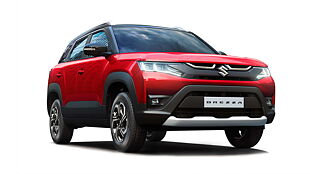What is it?
Why will I buy the Datsun redi-GO 1-litre
For extra grunt and real-world performance advantage over the 800cc model.
Why will I avoid the Datsun redi-GO 1-litre
It's still a little rough around the edges. Cars like the Hyundai Eon and Renault Kwid lend a more premium feel.

The Datsun redi-GO 1-litre aims at blending textbook small car efficiency with a bit of performance and finesse, unlike the standard 800cc model that focuses purely on maximum kilometres to the litre. The bump in power and torque figures will certainly help this new model’s case out on the highways but does it make the redi-GO significantly better? Let’s find out.
Unlike its closely related rival – the Renault Kwid 1-litre which is plastered with chequered decals on the sides and ORVMs with silver finish to differentiate it from the standard model, there are no tell-tale signs whatsoever (except for a tiny 1.0 badge over the boot lid) on the redi-GO 1-litre. This more powerful variant looks exactly the same as the 800cc redi-GO and retains that angular, tall boy design. All the design elements (including the hexagonal grille, chiselled bumpers, boomerang-shaped taillights and the bulging tailgate) that make the standard model stand out are on this car. All in all, the exterior design is pretty cohesive while the compact dimensions help keep the redi-GO’s footprint as diminutive as its name.

How is it on the inside?

Despite the pocket-size exterior, the cabin inside is more spacious than one would have expected. Cabin access is really easy because of its high stance (compared to other budget hatchbacks) and the overall visibility is excellent, too.
As you would expect, the dashboard layout is typically low-key, but the plastics are tough and hard-wearing. Otherwise the cabin is not a bad place to be – there’s a great sense of airiness compared to some of the other cars in this class, which is undoubtedly aided by the large glasshouse. Datsun has tried to make things look funky too, what with the unique rectangular centre air vent and the blue instrument panel.

The cabin is well thought-out at some places. The lower-half of the dash, for instance, gets exposed storage bins to store knickknacks and there’s decently large central stowage, too.
Frontal and side visibility is excellent; however, the same cannot be said for driving comfort as both the steering column and the seat are non-adjustable for height. Also, we noticed that the lower half of the centre console eats into the foot well, ultimately fouling with the driver’s left knee. That being said, the redi-GO scores well when it comes to rear seat comfort – the high mounted bench offers good under thigh support and the upright backrest feels comfortable too. Knee and head room are better than both the Alto K10 and the Eon. The Datsun also has a flat bench, which allows the occupants more room to move and has the advantage of being easier to accommodate three people across.

While the standard redi-GO is sold in five variants, this 1-litre version can be had in either T(O) or S trim. Both come with body coloured bumpers, piano black finish for the centre console, fabric seats, central locking, MP3 audio player and power windows, but safety features like daytime running lamps and driver airbag are exclusive to the more expensive S trim.
How does it drive?

The redi-GO is based on the same made for India CMF-A platform that underpins the Kwid, and it shares engine, gearbox, suspension and other bits with the Renault. Under the hood of this 1-litre model sits a 999cc, three-cylinder motor producing 68bhp of power and 91Nm of torque. Now these figures might seem modest but they account for plenty of pulling power for a tiny hatch like the redi-GO. In fact it’s a willing little unit, revving cleanly from about 2,500rpm and with great response to sudden throttle inputs. It offers decent punch on the move, but in traffic it’s not as impressive. Being a three cylinder motor, it vibrates at idle and there is that distant judder every time you release the clutch.

Cars like the redi-GO are designed primarily for inner city work and in that regard there’s plenty on offer. This 1-litre version is certainly peppier than the 800cc model, and offers more grunt in the midrange. When you are not working it hard, at low speed for example, it is quiet and unobtrusive. Around town, the redi-GO’s compact dimensions mean it’s easy to manoeuvre and park, and three-point turns don’t ruffle any feathers either.

As for high speed manners, the 800cc redi-GO isn’t really well suited for narrow two lane roads due to its lack of top-end grunt, but this 1-litre version is somewhat better suited – one can easily maintain speeds of up to 110kmph all day long. All in all, the way this engine sounds and builds up momentum is a lot like the Kwid 1-litre which isn’t a bad thing at all.

For a budget hatch, the redi-GO 1-litre tackles bad roads quite nicely. The long travel suspension and high profile tyres help it absorb potholes and bumps with aplomb. It even settles down well after bumps and ruts on the road. At higher speeds though, the suspension shimmies over mid-corner bumpers and transmits road joints into the cabin. The softly sprung setup means there’s more body roll and more importantly there’s some notable road noise from the suspension and wheels over rough surfaces.
Should I buy one?
Even though it’s far from perfect, the redi-GO 1-litre makes a strong case for itself as a budget hatch. Its nimble on the road, has great visibility all around, it’s easy to park and drive around in the city. What’s more, the funky design helps too – it certainly attracts more eyeballs than the ever popular Maruti Alto and the equally stylish Hyundai Eon.

To answer the big question, the redi-GO 1-litre, indeed, strikes a rational balance between efficiency and performance – it’s peppier and noticeably more potent in the real world than the 800cc version and as far as we can tell, it’s only marginally less efficient than the latter.
Where does it fit in?

The new Datsun redi-GO 1-litre competes in the highly competitive 1000cc small car segment. It will share market space with the likes of Maruti Suzuki Alto K10, Hyundai Eon 1-litre and its French sibling, the Renault Kwid 1-litre.

![Datsun redi-GO [2016-2020] Exterior Datsun redi-GO [2016-2020] Exterior](https://imgd.aeplcdn.com/642x361/cw/ec/30008/Datsun-RediGO-10-Exterior-102520.jpg?v=201711021421&wm=1&q=80)
![Datsun redi-GO [2016-2020] Right Front Three Quarter Datsun redi-GO [2016-2020] Right Front Three Quarter](https://imgd.aeplcdn.com/642x361/cw/ec/30008/Datsun-RediGO-10-Right-Front-Three-Quarter-102528.jpg?v=201711021421&wm=1&q=80)
![Datsun redi-GO [2016-2020] Right Rear Three Quarter Datsun redi-GO [2016-2020] Right Rear Three Quarter](https://imgd.aeplcdn.com/642x361/cw/ec/30008/Datsun-RediGO-10-Right-Rear-Three-Quarter-102559.jpg?v=201711021421&wm=1&q=80)
![Datsun redi-GO [2016-2020] Right Rear Three Quarter Datsun redi-GO [2016-2020] Right Rear Three Quarter](https://imgd.aeplcdn.com/642x361/cw/ec/30008/Datsun-RediGO-10-Right-Rear-Three-Quarter-102525.jpg?v=201711021421&wm=1&q=80)
![Datsun redi-GO [2016-2020] Rear View Datsun redi-GO [2016-2020] Rear View](https://imgd.aeplcdn.com/642x361/cw/ec/30008/Datsun-RediGO-10-Rear-view-102531.jpg?v=201711021421&wm=1&q=80)
![Datsun redi-GO [2016-2020] Rear View Datsun redi-GO [2016-2020] Rear View](https://imgd.aeplcdn.com/642x361/cw/ec/30008/Datsun-RediGO-10-Rear-view-102529.jpg?v=201711021421&wm=1&q=80)
![Datsun redi-GO [2016-2020] Left Side View Datsun redi-GO [2016-2020] Left Side View](https://imgd.aeplcdn.com/642x361/cw/ec/30008/Datsun-RediGO-10-Left-Side-View-102521.jpg?v=201711021421&wm=1&q=80)
![Datsun redi-GO [2016-2020] Left Front Three Quarter Datsun redi-GO [2016-2020] Left Front Three Quarter](https://imgd.aeplcdn.com/642x361/cw/ec/30008/Datsun-RediGO-10-Left-Front-Three-Quarter-102524.jpg?v=201711021421&wm=1&q=80)
![Datsun redi-GO [2016-2020] Image Datsun redi-GO [2016-2020] Image](https://imgd.aeplcdn.com/272x153/cw/ec/12795/Datsun-RediGO-Right-Front-Three-Quarter-91418.jpg?v=201711021421&q=80)























